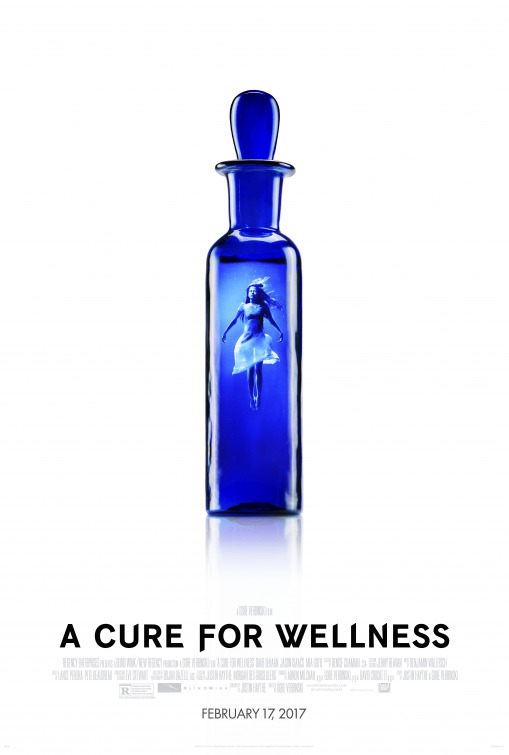Why Would You Want To Leave?
Director
Gore Verbinski
Starring
Dane DeHaan
Mia Goth
Jason Isaacs
The story wastes no time establishing Lockhart [DeHaan] as a callous, ambitious young employee for an unscrupulous financial services firm. The company receives a passionate, disturbing letter from its CEO, who is currently residing in a wellness facility in the Swiss Alps. Eager to merge their company and frame any irregularities on an unstable scapegoat, the board of executives effectively blackmails Lockhart into retrieving their wayward leader. Upon arrival, Lockhart finds the resort/facility to be laughably pointless and self-indulgent but is thwarted in his attempts to meet with his employer by the will of the unseen but highly revered director, Dr Volmer [Isaacs]. Intent on leaving as soon as possible, Lockhart is involved in a car accident and awakes in the facility three days later with a broken leg. As he hobbles around the facility, trying to locate the CEO, he learns about the sites dark history and becomes fascinated by the only other young patient, Hannah [Goth].
A Cure For Wellness is such a strange medley; a European-flavoured mix of gothic horror, Shutter Island, BioShock and The Road To Wellville. This combination of reclusive societies, cultist practices and gory, unpleasant experiments sets a really engrossing tone for audiences. Unfortunately, its full potential is never realised and what we end up with is a pleasing but ultimately flawed work. Undoubtedly, this movie’s key strengths are the beautiful production design, fantastic cinematography and keen composition. It’s almost impossible to fault the visuals throughout, which serve to create a unique environment for Lockhart’s perplexing psychological journey. Interestingly, despite being branded as a horror, Verbinski’s latest release feels more like a slow-burn suspense thriller (with a somewhat unreliable narrator), than a clean-cut jump-scare riddled horror film. That’s not to say it isn’t filled with immense cliché – as horror tends to be – but its beauty lies in its straightforward unwavering simplicity and defiance of logic, akin to a dream. That being said, for a mystery, it’s very obvious and everyone Lockhart encounters being a bit of an expert on a local legend yet having their own spin on it doesn’t have the desired effect; leaving a very predictable driving subplot that doesn’t so much seductively unfurl as unravels within the first ten minutes.
Owing to the contained nature of the story, there isn’t a great deal of supporting characters that are afforded much in the way of screen time or proper fleshing out. The three leads are that of Lockhart, Volmer and Hannah with several orderlies, doctors and patients acting as road signs for Lockhart’s “investigation.” I’m a fan of Jason Isaacs and despite playing the rather obvious Germanic-voiced villain (a fact which is never in any doubt, despite the script’s desperate attempts to throw audiences off the twist), he does a decent job. In fact, knowing Verbinski likes to call back to classic releases and genres, his channeling of the 1930’s calculating mad scientist is most impressive. Dane DeHaan was also an interesting choice, despite being 31 years old, the man looks like he’s fresh out of his teens but placing someone like that in a role of power-hungry yuppy financier works in his favour, having the ability to channel both desperate panic and selfish malevolence; a duality which means he simultaneously plays both the victim and villain. Another piece of obvious casting is that of Mia Goth. I’ve only seen her in Nymphomaniac but her otherworldly disconnection makes her perfect for this innocent role; sort of Sissy Spacek in Carrie, only without the powers. And yet, as commendable as the performances are they lack cohesive motivation, shifting wildly between what they want. At one point Lockhart seems set on escaping then he’s determined to uncover the mystery and then he wants to liberate Hannah; none of it really gels with the self-centred character we have been introduced to, even with any altered psychological side-effects or fear of prosecution should he return to New York empty handed. And it doesn’t exactly help that everyone he speaks with gets a slew of sincere babbling about the Baron’s experiments, despite one character overtly stating, “Yes but that was two hundred years ago.”
For all its style and slick visuals, A Cure For Wellness has very little depth or substance. I wouldn’t be surprised if less trained eyes (that’s not an insult, after you’ve seen so many films, formulas and patterns simply present themselves to you) would be shocked and bamboozled as the story unfolds but in truth everything is literal, there’s little in this film that doesn’t state matters frankly and explain itself. Sure there’s an air of ambiguity throughout but the central story is very easy to pick apart. Again, I will give credit where due and argue that if this is a mirroring of classic suspense horror, then it’s merely following a specific, if not dated, style but even then one would hope that weaknesses could be strengthened thanks to decades of revelations and hindsight. If I’m honest, I think this movie would have worked infinitely better if it were a straight period film. There are already elements and nods littered throughout the production design, from the antiquated props to the questionable medical equipment on display. Had this movie been set in the late 1800s or even a pre-World War 1 era, it might have garnered a bit more grace but every time you are reminded this is taking place in the present day, we’re momentarily shaken free from the illusion.
Of course, it’s not all bad, repeat viewings and time could prove A Cure For Wellness to be a cult sleeper as ultimately there could be a hidden depth to this film thanks to few flashes of either a potential future or the implication that the ending may be a dream/final fantasy of a dying brain. In fact, one particular shot of Lockhart on a bridge (you’ll hopefully know what I’m talking about if you’ve seen the film) could imply the entire film is a fantasy. In a way, A Cure For Wellness is very reminiscent of Crimson Peak, wherein an extremely talented visual director has produced an unsettling semi-unconventional horror harking back to releases of yesteryear, with surprisingly middling results.
Release Date:
24th February 2017
The Scene To Look Out For:
For those who don’t know, horror only works when the sound design is on top form. You can present a startling image or excessive gore but the more you look at it, the less impact it has; which is where sound comes in. In order to create tension and scare the living piss out of you, one needs an appropriately clever and perfectly timed layering of musical cues, ambient hums and unique effects. Less a scene to highlight in that sense and more a continuing unpleasantness: throughout the movie there is a heightened focus on the sounds made when water is drunk. This will no doubt trigger misophoniacs but even those who pay little attention to the sound of people consuming food and drink will feel suitably uncomfortable.
Notable Characters:
Exploring the supporting cast for a second, I rather enjoyed the repeat appearances of the somewhat aloof Enrico [Ivo Nandi], the driver contracted to transport newly inducted patients from the train station to the facility. Solidifying the classic gothic homage, his character is basically the wary, exposition-disposing carriage driver archetype. In truth, he doesn’t actually bring a great deal to the story itself but I found the performance strangely endearing and, in a film so separated from reality, believable. I think if there were any relatable individuals for the audience to identify with, it’d be him.
Highlighted Quote:
“We cheat and deceive as we claw our way to the pinnacle of human achievement”
In A Few Words:
“An ambitious gothic attempt but a flawed foundation and overt twist result in a fairly mediocre release”
Total Score: 3/5
![The Red Right Hand Movie Reviews [Matthew Stogdon]](https://reviews.theredrighthand.co.uk/wp-content/uploads/2021/12/cropped-header1.png)




